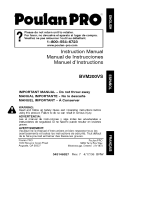
-- 3 --
D Keep children, bystanders, and animals away
from work area a minimum of 15 meters when
starting or operating unit. Do not point blower
nozzle in the direction of people or pets.
HANDLE FUEL WITH CAUTION
D Eliminate all sources of sparks or flame
(including smoking, open flames, or work that
can cause sparks) in the areas where fuel is
mixed, poured, or stored.
D Mix and pour fuel in an outdoor area; store
fuel in a cool, dry, well ventilated place; use an
approved, marked container for all fuel
pu r p o se s.
D Do not smoke while handling fuel or while
operating the unit.
D Make sure the unit is properly assembled and
in good operating condition.
D Do not fill fuel tank while engine is hot or
running.
D Avoid spilling fuel or oil. Wipe up fuel spills
before starting engine.
D Move at least 3 meters away from fuel and
fueling site before starting engine.
D Always store petrol in a container approved
for flammable liquids.
OPERATE YOUR UNIT SAFELY
WARNING: Stop the engine before
opening the vacuum inlet door. The engine
must be stopped and the impeller blades no
longer turning to avoid serious injury from the
rotating blades.
D Inspect unit before each use for worn, loose,
missing, or damaged parts. Do not use until
unit is in proper working order.
D Keep outside surfaces free of oil and fuel.
D Never start or run engine inside a closed
room or building. Breathing exhaust fumes
can kill.
D Muff lers fitted with catal ytic converters get
very hot during use and remain so for some
time after stopping. This also applies at idle
speed. Contact can result in burns to the skin.
Remember the risk of fire!
D To avoid static electricity shock, do not wear
rubber gloves or any other insulated gloves
while operating unit.
D Do no t set unit on an y surface except a clean,
hard area while engine is runni ng. Debris
such as gravel, sand, dust, grass, etc. could
be picked up by the air intake and thrown out
through discharge opening, damaging unit,
property , or causing serious injury to
bystanders or operator.
D Avoid dangerous environments. Do not use in
unventilated areas or where explosive vapors
or carbon monoxide build up could be
present.
D Do not overreach or use from unstable
surfaces such as ladders, trees, steep
slopes, rooftops, etc. Keep firm footing and
balance at all times.
D Never place objects inside the blower tubes;
always direct the blowing debris away from
people, animals, glass, and solid objects such
as trees, automobiles, walls, etc. The force of
air can cause rocks, dirt, or sticks to be
thrown or to ricochet which can hurt people or
animals, break glass, or cause other damage.
D Never run unit without the proper equipment
attached. When using your unit as a blower ,
always install blower tubes. When using your
unit as a vacuum, always install vacuum
tubes and vacuum bag assembly. Make sure
vacuum bag assembly is completely zipped.
D Check air intake opening, blower tubes,
vacuum tubes, and elbow tube frequently,
always with engine stopped and spark plug
disconnected. Keep vents and discharge
tubes free of debris which can accumulate
and restrict proper air flow.
D Never place any object in the air intake
opening as this could restrict proper air flow
and cause damage to the unit.
D Never use for spreading chemicals, fertilizers,
or other substances which may contain toxic
materials.
D To avoid spreading fire, do not use near leaf or
brush fires, fireplaces, barbecue pits,
ashtrays, etc.
D Use only for jobs explained in this manual.
MAINTAIN YOUR UNIT PROPERLY
D Have all maintenance other than the
recommended procedures described in the
instruction manual performed by an
authorized service dealer.
D Disconnect spark plug before performing
maintenance except for carburetor
adjustments.
D Use only recommended M cCulloch®
replacement parts; use of any other parts
may void your warranty and cause damage to
your unit.
D Empty fuel tank before storing the unit. Use
up fuel left in carburetor by starting engine and
letting it run until it stops.
D Do not use any accessory or attachment
other than those recommended by
manufacturer for use with your unit.
D Do not store the unit or fuel in a closed area
where fuel vapors can reach sparks or an
open flame from hot water heaters, electric
mo t o r s or switch es, fur n a ce s, etc.
D Store in a dry area out of reach of children.
SAFETY NOTICE: Exposure to vibrations
through prolonged use of gasoline powered
hand tools could cause blood vessel or nerve
damage in the fingers, hands, and joints of peo-
ple prone to circulation disorders or abnormal
swelling. Prolonged use in cold weather has
been linked to blood vessel damage in other-
wise healthy people. If symptoms occur such as
numbness, pain, loss of strength, change in skin
color or texture, or loss of feeling in the fingers,
hands, or joints, discontinue the use of this tool
and seek medical attention. An antivibration
system does not guarantee the avoidance of
these problems. Users who operate power tools
on a continual and regular basis must monitor
closely their physical condition and the condition
of this tool.












